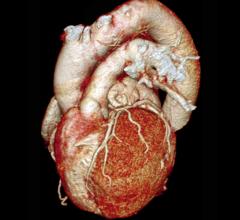June 10, 2008 – A new calcium scoring method, which takes into account not only the amount of calcified plaque build-up in the coronary arteries but also its distribution, may better predict a person’s risk of heart attack, according to a new multicenter study published in the June issue of the journal Radiology.
“Now we know that the location of the calcium in the arteries is particularly important in estimating a patient’s potential risk,” said the study’s lead author, Elizabeth Brown, Sc.D., research assistant professor in the Department of Biostatistics at the University of Washington in Seattle.
Heart disease is the leading cause of death in the U.S. Each year, 700,000 Americans die of heart disease, according to the Centers for Disease Control and Prevention. The most common form of heart disease in the U.S. is coronary artery disease, which is caused by a build-up of calcific plaque in the coronary arteries leading to the heart. The current standard of coronary calcium measurement gauges only the amount of calcium present in the arteries, not its spatial distribution.
“Currently, physicians only see the result in terms of an overall score designed to measure the amount of calcified plaque,” Dr. Brown said. “This new approach will provide physicians with a measure of the proportion of the arteries affected.”
The Multi-Ethnic Study of Atherosclerosis (MESA) began in July 2000. The prospective study included 6,814 men and women between the ages of 45 and 84. The researchers compared CT image data for 3,252 participants with calcific plaque to data collected from 3,416 patients without calcific plaque. (Due to lack of sufficient CT image data, 146 additional MESA participants were excluded from this analysis.) A calcium coverage score was developed to estimate the percentage of coronary arteries affected by plaque.
The patients were then followed up for a median period of 41 months to determine if there was a relationship between the distribution of calcium shown in the CT images and the likelihood heart attack or other cardiac event.
The results showed that diabetes, hypertension and dyslipidemia (abnormal concentrations of lipids [fats] or lipoproteins in the blood) were highly associated with calcium coverage score. The study also found that the calcium coverage score—which takes into account the location of the calcium—was a better predictor of future cardiac events than currently used measures that gauge only the amount of calcium present. On average, compared to patients without diabetes, patients with diabetes had 44 percent more of their coronary arteries affected by plaque. A twofold increase in calcium coverage score indicated a 34 percent increase in risk of heart attack or other serious cardiac event and a 52 percent increase in the risk of any cardiac event.
“Calcium coverage scoring has the potential to improve our estimate of a patient’s risk for adverse clinical outcomes, such as heart attacks or death,” Dr. Brown said.
Source: The Radiological Society of North America, Inc.
For more information: RSNA.org/radiologyjnl


 December 19, 2024
December 19, 2024 








